Topic
Announcement: Art, creativity, and life call for the recognition
that we are not all the same; nor do we necessarily express the same views.
Teaching art may thus mean showing how to express but not what to express.
Antonio García, VCU’s Director of Jazz Studies, shares his thoughts
about the beauty in the differences all around us.
Good
morning!
I
thank you for asking me to share this morning with you. I am honored that
you would ask me to share my thoughts with you about creativity, art, and
even spirituality; and I am looking forward to our discussion in a few moments.
I have visited your church and other UU churches in the past and received
inspiration; so I hope that I can provide something of interest and inspiration
to you today.
When Autumn Fehr first contacted me about joining you today, I was quite surprised; but my topic very quickly came to mind: “The Beauty is in the Difference.” It’s a saying that has been around for I-don’t-know-how-long, yet not much may really be known about its origins. In fact, if you turn to the mother tool of modern research—Google—and place that phrase in quotation marks, you’ll receive only about a dozen references, each merely incidental uses of the phrase.
Physical
Beauty
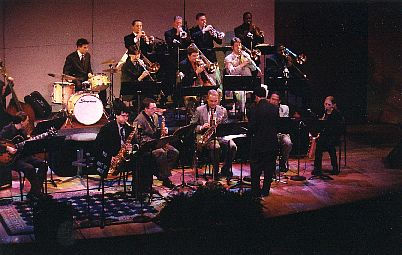 |
|
García leads the
VCU Jazz Orchestra I in concert. Photo credit: Eric Norbom |
Yet this is a phrase that has been a center of my perception of the world for my entire adult life. For example, I recall that when I was a dating teenager—or a lot of the time, more accurately, a teenager looking for a date—I was just stunned by the variety of attractive women out there. They were all over! And yet, they had such pressure to conform to whatever the cultural standard of the time was for beauty, be it hair-length or shoe-height or style of glasses—or no glasses at all. Guys, of course, had fewer pressures put upon them for style and fashion: we were just…guys.
As I aged into college years, I had a steady girlfriend; so that made me non-threatening enough that other women would also talk to me about their lives; and I could see that these pressures on women to conform to the standard hadn’t lessened. Some of my friends had serious self-esteem issues because they didn’t match the fashion ads’ version of womanhood. And I would think—and sometimes outright tell them: “HEY! ‘The Beauty is in the Difference!’ The things that make you unusual are the things that make you individual—and to me, attractive.”
Nowadays I watch those cultural pressures on young women increase to the point where we have a network TV show called “The Swan,” where “ugly ducklings” are made over into “beautiful swans.” It may be a decade before we know what damage has been done, both to the young women who might watch and value such physical transformations and to the young men who might watch and establish a value system that has no room for “The Beauty is in the Difference.”
Same
Yet Different
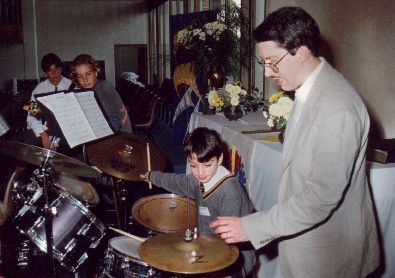 |
William gets a drum set lesson from Antonio García at Christchurch Grammar School in Perth, Australia as Josh and Haslett look on. Photo credit: Graham Nielsen, Christchurch
|
One of my favorite activities in public places is “people-watching.” Some places seem to teem with interesting-looking people…and often beautiful people. I remember that when I was visiting the famed city of Nice, France I was struck by how every man, woman, and child—no matter how young or how old—was model quality. You could place them in Vogue magazine or National Geographic or Life; and they’d just leap off the pages. With every step I took on the streets, I would just marvel at “The Beauty in the Difference” of creation itself! For me, these are spiritual moments in which I feel I have experienced some part of the origin of the universe.
Airports are great for people-watching; and on rare occasion there I will stumble onto one of my favorite finds: someone who looks exactly like someone else I know. I can’t get over that. And I think, with all the variety I’ve seen over the years, how oddly unique is it to see someone who’s not different! I mean, it’s kind of like the notion that if everyone is rebelling, soon the only way to rebel is not to rebel. The “rarity of the identical” makes me appreciate the differences even more!
The
Jazz Ideal
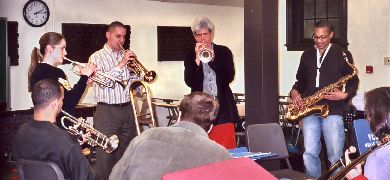 |
|
VCU faculty trumpet
professor Rex Richardson (left center) and guest trumpeter John D'earth
(right center) trade solos with VCU students. Photo
credit: Antonio J. García
|
What
does this have to do with my creative life, specifically in jazz music and
jazz education? A lot. It’s common that a young high school or
college-age musician seeking to grow in jazz expression might initially be
waiting for the day when instead of wondering what he or she might play during
their solo improvisations over a given tune or performance, they’ll
“just know” what they’ll play—and thus jazz expression
will be safer, more predictable.
And
then, gradually or sometimes quickly, these students of the music realize
that their goal is not to arrive at safety and predictability at all—that
that would actually be the enemy of learning how to improvise jazz
solos or even of writing jazz compositions. In fact, their goal is to be different,
to be individual—and in large part to do so by observing “The
Beauty in the Difference” around them at that given moment of performance
and incorporate that into their solo expression. David Liebman, an articulate
jazz educator and musician, says, “The beauty of art is its universality
contrasted by its uniqueness…. Much like art, the essence of a human
being consists of many universal and unique attributes.”
As
one living legend of jazz, trumpeter Clark Terry, long ago summarized the
jazz learning process: “Assimilate. Imitate. Innovate!” Sure,
it’s fine to start by imitating the standards of the society around
you, musical or otherwise. Internalize it and understand it and be able to
express it. But then, build on it. And that’s the challenge of
not just the jazz life, but of the creative life. The acclaimed classical
composer Bela Bartok stated, “Only from the entirely old can the entirely
new be born.”
So the jazz musician’s goal is not to predict what is to happen and be comforted by that knowledge; it is to recognize that one not only cannot predict what will happen but would be bored if one could! The comfort comes not in knowing the future but in having spent a creative lifetime responding spontaneously to surprising possibilities—and enjoying the ride those surprises give us. To put it in the words of the author from whom you’ve already heard some readings today, Stephen Nachmanovitch, “Practice gives the creative processes a steady momentum, so that when imaginative surprises occur (whether they be thrown toward us by accident or brought up from within by the unconscious), they can be incorporated into the growing, breathing organism of our imagination.”
As
in Jazz,
So In Life
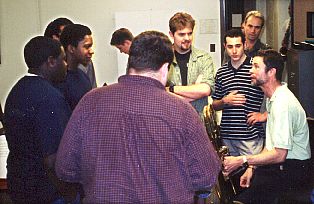 |
|
Guest trombonist Ray
Anderson chats with VCU students during a rehearsal break. Photo credit: Antonio García |
Nachmanovitch
must be an interesting character. His bio says that he is a “violinist,
composer, poet, teacher, and computer artist who studied psychology and literature
at Harvard and has a Ph.D. in the History of Consciousness from the University
of California at Santa Cruz.” I’ve never met anyone with a degree
in the History of Consciousness; and the very title of the degree sounds daunting—do
you cover the History of Consciousness in two years or four years? Do you
have to stay awake for all the classes?
Nonetheless
his book, Free Play: The Power of Improvisation in Life and the Arts,
has become a handy reference for me and an appropriate link for today’s
talk about creativity in music and in life. The parallels are strong.
For
example, he says, “An improviser may have to practice for years before
being able to play a totally spontaneous minute of music in which every detail
is right for its own fleeting moment....The fruits of improvising, composing,
writing, inventing, and discovering may flower spontaneously, but they arise
from soil that we have prepared, fertilized, and tended in the faith that
they will ripen in nature’s own time.” That’s not necessarily
what an 18 year-old future jazz musician wants to hear, but it’s true
in life as well.
I
have often told improvisation students, “Look. I can’t teach you
improvisation. You’ve been doing that all your life. You already know
how to improvise. How many of you have had an unscripted conversation with
someone else this week?” But what I can do is assist them in finding
their own routes to express that improvisation through music.
To quote Nachmanovitch again, “The Western idea of practice is to acquire a skill. It is very much related to our work ethic, which enjoins us to endure struggle or boredom now in return for future rewards. The Eastern idea of practice, on the other hand, is to create the person, or rather to actualize or reveal the complete person who is already there.”
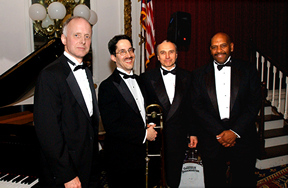 |
|
Four of the ten VCU
Jazz faculty at a university reception: Bob Hallahan (piano), Antonio
García (trombone), Victor Dvoskin (bass), and former member Howard
Curtis (drums).
Photo credit: courtesy VCU |
Through it all, we seek balance, another angle that applies to music and to life. David Liebman defines a jazz musician in what I believe is a most articulate way: “An ideal aesthetic combination for an improvising musician would be total control of the rules of music, instrumental virtuosity, mental and intellectual depth, and the looseness of personality which allows these factors to mix spontaneously in a balanced fashion.” That, to me, is a wish list for a jazz musician that also has parallels in real life.
So I can’t teach a jazz musician what to play or, musically, “say.” But if I’m fortunate, I can teach musicians how to express what they want to play. It’s like that old saying that differentiates between giving a person a fish and teaching a person how to fish: the latter can last the person a lifetime.
Tolerance:
Celebrate the
Difference!
Ultimately,
the musicians I teach may end up playing or musically “saying”
something I’m not a big fan of. That’s not really my business:
it’s my gig to support their growth towards their
goals, so long as they can also complete the university degree. I should have
a high tolerance for “The Beauty in The Difference” of what they’re
expressing versus what I might choose to express myself. That, too, has great
parallels in real life.
If I have come away with any one principle accentuated by my own occasional visits to the Unitarian Universalist Church services, it is that tolerance of the differences among us is crucial to positive growth in our humanity. Sure, we all have to draw the line somewhere, where we feel for example that our own moral code is otherwise compromised; but tolerance of views other than ours is no less than a key to survival.
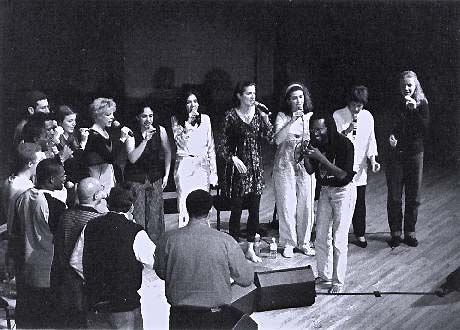 |
Guest artist Bobby McFerrin and his Voicestra along with members of the NU Vocal Jazz Ensemble directed by Antonio García. |
When, some months ago, I accepted your invitation to speak to you today, it never occurred to me that this would be the Sunday following Election Day, the conclusion of perhaps one of the bitterest, most antagonistic, most negative campaign seasons in our history. I felt fortunate to avoid much of the community conflict; but even I witnessed social and business occasions when conversations took an ugly turn.
No matter from which political party affiliation my individual friend or neighbor or colleague spoke, the approach was the same. It would go something like this—for which I’ll invent the fictional, political party of your non-choice: the despised “DemoPublicats.”
“Things were fine in my neighborhood until all those DemoPublicats moved in. They’re so ignorant.” Or, “Our lives will go to hell if the DemoPublicats run the country for the next four years.” No matter which way the election turned out, I knew I was going to have some depressed friends this week.
But I was struck by how sweeping and intolerant so much of the conversation was. Imagine, for a moment, if instead of “DemoPublicats” you inserted the word “women”…or “Jews”… or “gays”…or “Hispanics.”
“Things were fine in my neighborhood until all those Hispanics moved in. They’re so ignorant.” Or, “Our lives will go to hell if women run the country for the next four years.” Since when did it become any more acceptable to stereotype voters than it would be to assume that all Jews have identical beliefs on issues—or than all gay people would vote the same on a given civic referendum?
I say, “The Beauty is in the Difference.” To me, there is no greater day on the political calendar than Inauguration Day, when civic powers change hands without rancor, without violence—because of the close-second-greater day of Election Day, when each individual gets to declare his or her views as the same or different than the next person’s.
Those days may not go my preference any more than I can control the musical expression of my students—or any more than I can predict the outcome of a jazz solo I’m about to take. But each of those expressions strikes me as the individual, creative, artistic “Beauty in the Difference”; and I invite you to celebrate that at every opportunity in your lives.
Experience
Life As
It Is
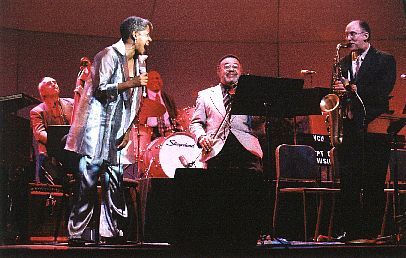 |
|
Guests René Marie
(vocals) and Joe Kennedy, Jr. (violin) in concert with VCU Jazz faculty
Victor Dvoskin (bass), Howard Curtis (drums), and Skip Gailes (saxophone). Photo credit: Eric Norbom |
I hope you enjoyed the Prelude, “How Can I Keep From Singing,” sung by once-local artist René Marie. The Postlude will be a another version of hers as well. I chose the piece intentionally. Musicians—artists—create because they must. Yet each person on this earth creates, differently, often beautifully, each day. As Stephen Nachmanovitch says, “The free play of creativity...is the ability to experience life as it is.” I wish you that experience, each and every day.
To celebrate life, I’d like to share with you now some music-making with friends of mine. We’d like to perform for you a wonderful composition by George Gershwin titled, “They Can’t Take That Away From Me,” after which we will all gather for our discussion this morning.
Thank you again for the honor of speaking with you today!
##################
ADDITIONAL RESOURCES
-
Nachmanovitch, Stephen. Free Play: The Power of Improvisation in Life and the Arts. (© 1990 Stephen Nachmanovitch), published by The Putnam Publishing Group (republished 1991 by Tarcher), ISBN 0-87477-631-7, 224-page paperback, lists for $12.95.
-
García, Antonio. “Improve Your Improv—Not Just What You Say, But How You Say It,” Down Beat, Vol. 61, No. 9, September 1994 (and online within this same “Articles” section of my web site).
##################
 |
|
Antonio García scat-sings in a clinic session with the trio of Melvin Peters (piano), Bucco Xaba (drums), and Mike Campbell (bass) at The South African Jazz Educators Conference in Pretoria, South Africa. |